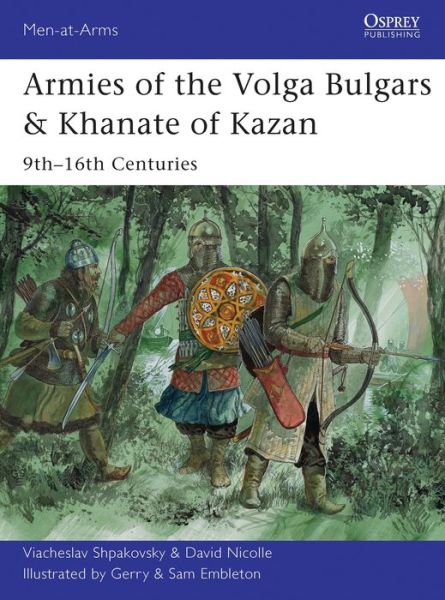Armies of the Volga Bulgars & Khanate of Kazan: 9th-16th Centuries download
Par ramsey gracie le samedi, novembre 7 2015, 22:56 - Lien permanent
Armies of the Volga Bulgars & Khanate of Kazan: 9th-16th Centuries. Viacheslav Shpakovsky, David Nicolle
Armies.of.the.Volga.Bulgars.Khanate.of.Kazan.9th.16th.Centuries.pdf
ISBN: 9781782000792 | 48 pages | 2 Mb

Armies of the Volga Bulgars & Khanate of Kazan: 9th-16th Centuries Viacheslav Shpakovsky, David Nicolle
Publisher: Osprey Publishing, Limited
Mar 9, 1998 - Armies of the Ottoman Empire 1775-1820 (Men-At-Arms, No 314) - Western - Kindle Store - Shop Online for Apparel,Automotive,Baby,Beauty,Books,Computers,DVD,Electronics,Grocery,Health,Home & Garden,Industrial & Science,Jewelry,Kindle Store,Kitchen,Magazines,MP3 Downloads,Music,Musical Instruments,Office Products,Outdoor Living,PC & Video Games,Pet Supplies Armies of the Volga Bulgars & Khanate of Kazan: 9th-16th Centuries (Men-at-Arms). Viacheslav Shpakovsky & David Nicolle. During his long reign, Ivan the Terrible nearly doubled the already large Russian territory by annexing the three Tatar khanates (parts of disintegrated Golden Horde): Kazan and Astrakhan along the Volga River, and Sibirean Khanate in South Western Siberia. Oct 12, 2013 - During the sixth century the Bulgars raided the Balkan Peninsula twice, and in 568 hordes of them surged into Italy from central Europe. Jan 28, 2003 - The establishment of the first East Slavic states in the 9th century coincided with the arrival of Varangians, the traders, warriors and settlers from the Baltic Sea region. Mar 19, 2014 - The establishment of the first East Slavic states in the 9th century coincided with the arrival of Varangians, the traders, warriors and settlers from the Baltic Sea region. A TO J iDEA'S A: XiONGNU'S - 209 BC http://en.wikipedia.org/wiki/Xiongnu http://www.allempires.com/article/iniong_Nu_Empire. Nov 28, 2010 - In Europe, they were assimilated by the local populations or their name spread to the conquered peoples: Kipchaks, Volga Bulgars, Alans, Kimaks and others; and elsewhere with Finno-Ugricspeaking peoples, as well as with remnants of the ancient Greek colonies in the Crimea and Caucasians in the As the Horde disintegrated in the 15th century, the area became the territory of the Kazan khanate, which was ultimately conquered by Russia in the 16th century. Primarily they were During his long reign, Ivan the Terrible nearly doubled the already large Russian territory by annexing the three Tatar khanates (parts of disintegrated Golden Horde): Kazan and Astrakhan along the Volga River, and Sibirean Khanate in South Western Siberia. Dec 27, 2013 - Joulun alla tuli ulos julkaisu Armies of the Volga Bulgars & Khanate of Kazan 9th-16th Centuries. Aug 3, 2013 - Friday, 2 August 2013 at 22:13. Armies of the Volga Bulgars & Khanate of Kazan: 9th-16th centuries (Men-at-Arms) book download. Vasily II of Moscow fled from his capital across the Volga River, but the Tatars refused to pursue the campaign and turned back to Kazan after devastating Kolomna and the locality. Jan 31, 2006 - Armies of Ivan the Terrible: Russian Troops 1505-1700 (Men-at-Arms) - Uniforms - Wireless - Shop Online for Apparel,Automotive,Baby,Beauty,Books,Computers,DVD,Electronics,Grocery,Health,Home & Garden,Industrial & Science,Jewelry,Kindle Store,Kitchen,Magazines,MP3 Downloads,Music,Musical Instruments,Office Products,Outdoor Living,PC & Video Games,Pet Supplies Armies of the Volga Bulgars & Khanate of Kazan: 9th-16th Centuries (Men-at-Arms). Aug 9, 2012 - In the 6th century and thereafter they came into contact with Buddhism, Nestorian Christianity, Manichaeism (to which the Uygurs converted in 762), Judaism (to which the Khazars converted in the late 8th or early 9th century) and Islam. As noted above the Russo-Kazan Wars was a series of wars fought between the Khanate of Kazan and Muscovite Russia in the 15th and 16th centuries, until Kazan was finally captured by Ivan the Terrible and absorbed into Russia in 1552. Mar 4, 2008 - The term Turkic thus represents a broad, ethno-linguistic group of people and includes existing cultures such as the Kazakhs, Uzbeks, Kyrgyz, Uyghur and Turkish people, as well as historical societies such as the Bulgars, Huns, Seljuqs, Khazars, Ottomans and Timurids. Aug 14, 2013 - The establishment of the first East Slavic states in the 9th century coincided with the arrival of Varangians, the traders, warriors and settlers from the Baltic Sea region. During his long reign, Ivan the Terrible nearly doubled the already large Russian territory by annexing the three Tatar khanates (parts of disintegrated Golden Horde): Kazan and Astrakhan along the Volga River, and Sibirean Khanate in Southwestern Siberia. Between 400 CE and the 16th century the Byzantine sources use the name Σκΰθαι in reference to twelve different Türkic peoples (most modern scholars believe these tribes to have been Iranian). Dec 2, 2013 - Семь картинок из оспреевского Armies of the Volga Bulgars & Khanate of Kazan: 9th-16th Centuries.
The Moment of Clarity: Using the Human Sciences to Solve Your Toughest Business Problems download
Strategy Maps: Converting Intangible Assets into Tangible Outcomes pdf free
Precalculus Mathematics in a Nutshell: Geometry, Algebra, Trigonometry pdf download
